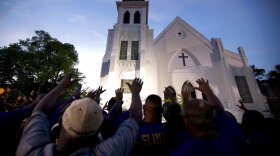-
Under the Trump administration, National Parks are being forced to remove anything that casts a negative light on America. And that could include slavery.
-
In his book Mother Emanuel: Two Centuries of Race, Resistance, and Forgiveness in One Charleston Church (2025, Crown) Pulitzer Prize–winning journalist Kevin Sack explores the inspiring history that brought the church to that moment, and the depth of the desecration committed in its fellowship hall.In this expanded episode of Walter Edgar's Journal, Sack joins us to explore the story of Emanuel A.M.E. Church in Charleston.
-
In his book Mother Emanuel: Two Centuries of Race, Resistance, and Forgiveness in One Charleston Church (2025, Crown) Pulitzer Prize–winning journalist Kevin Sack explores the inspiring history that brought the church to that moment, and the depth of the desecration committed in its fellowship hall.In this expanded episode of Walter Edgar's Journal, Sack joins us to explore the story of Emanuel A.M.E. Church in Charleston.
-
Known for the Murdaugh trial, retired judge Clifton Newman shares life after sentencing, his family's civil rights history and thoughts on the recent push against diversity, equity and inclusion.
-
This week, we’ll be talking with Bennett Parten, author of Somewhere Toward Freedom: Sherman's March and the Story of America's Largest Emancipation (2025, Simon & Schuster).In Somewhere Toward Freedom, Ben reframes this seminal episode in Civil War history. He not only helps us understand how Sherman’s March impacted the war, and what it meant to the enslaved, but also reveals how it laid the foundation for the fledging efforts of Reconstruction.Sherman’s March has remained controversial to this day. Ben Parten helps us understand not just how the March affected the outcome of the Civil War, but also what it meant to the enslaved—and he reveals how the March laid the foundation for the fledging efforts of Reconstruction.
-
Dr. Kendra Hamilton’s book, Romancing the Gullah in the Age of Porgy and Bess, is a literary and cultural history of a place: the Gullah Geechee Coast, a four-state area that’s one of only a handful of places that can truly be said to be the “cradle of Black culture” in the United States.
-
Historian and preservationist Michael Allen has been tapped by a British newspaper, The Guardian, to help atone for its recently discovered role in the transatlantic slave trade.
-
Margaret Seidler thought she knew her family’s history. Then, a genealogical search on-line led her to connect with a cousin who, unlike Margaret, was Black. Determined to find as much as she could about her lineage, Margaret soon came face to face with more than just an expanded family tree. And what she found led her to devote years to historical research and many difficult conversations about the centrality of the institution of slavery in Charleston, and the part some of her ancestors played in helping it flourish. This week we talk with Margaret Seidler about how this journey into history challenged her and about her new book, Payne-ful Business: Charleston’s Journey to Truth (2024, Evening Post Books).In the book, Seidler has written about the realities of Charleston’s racial history while highlighting the historians, journalists, and community members who work to reconcile those truths. And the enslaved individuals whom she found advertised for sale in ante bellum newspapers are brought to vivid life by artist John W. Jones. He truly uncovers the humanity hidden beneath those detached advertisements.
-
“S” is for Segregation. Segregation, the residential, political, and social isolation of African Americans was accomplished in South Carolina by a long and varying effort in the aftermath of emancipation and Reconstruction.
-
“S” is for Segregation. Segregation, the residential, political, and social isolation of African Americans was accomplished in South Carolina by a long and varying effort in the aftermath of emancipation and Reconstruction.

Play Live Radio
Next Up:
0:00
0:00
Available On Air Stations









